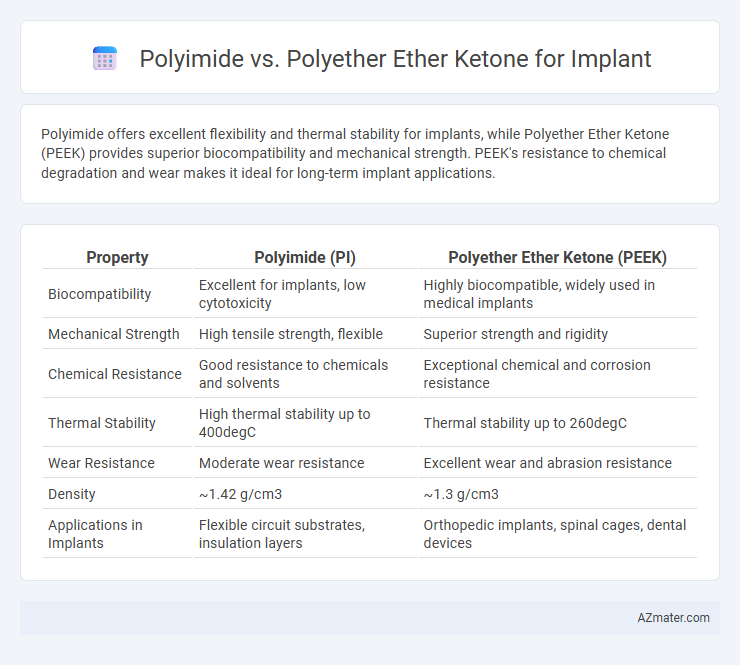Polyimide offers excellent flexibility and thermal stability for implants, while Polyether Ether Ketone (PEEK) provides superior biocompatibility and mechanical strength. PEEK's resistance to chemical degradation and wear makes it ideal for long-term implant applications.
Table of Comparison
| Property | Polyimide (PI) | Polyether Ether Ketone (PEEK) |
|---|---|---|
| Biocompatibility | Excellent for implants, low cytotoxicity | Highly biocompatible, widely used in medical implants |
| Mechanical Strength | High tensile strength, flexible | Superior strength and rigidity |
| Chemical Resistance | Good resistance to chemicals and solvents | Exceptional chemical and corrosion resistance |
| Thermal Stability | High thermal stability up to 400degC | Thermal stability up to 260degC |
| Wear Resistance | Moderate wear resistance | Excellent wear and abrasion resistance |
| Density | ~1.42 g/cm3 | ~1.3 g/cm3 |
| Applications in Implants | Flexible circuit substrates, insulation layers | Orthopedic implants, spinal cages, dental devices |
Introduction to Polyimide and Polyether Ether Ketone (PEEK)
Polyimide and Polyether Ether Ketone (PEEK) are high-performance polymers widely utilized in medical implants due to their exceptional thermal stability, mechanical strength, and biocompatibility. Polyimide exhibits outstanding flexibility and chemical resistance, making it ideal for long-term implantable devices requiring durability and flexibility. PEEK offers superior mechanical rigidity, excellent wear resistance, and radiolucency, which supports its use in load-bearing orthopedic and spinal implants.
Material Composition and Structure Comparison
Polyimide and Polyether Ether Ketone (PEEK) differ significantly in material composition and molecular architecture, impacting their suitability for implants. Polyimide is characterized by aromatic polyimide rings connected by imide linkages, offering high thermal stability and mechanical strength due to rigid, planar chains. PEEK, a semi-crystalline thermoplastic, consists of repeating ether and ketone functional groups along an aromatic backbone, providing excellent chemical resistance, biocompatibility, and toughness, which are critical for long-term implant performance.
Mechanical Properties: Strength and Flexibility
Polyether Ether Ketone (PEEK) exhibits superior mechanical strength and enhanced flexibility compared to Polyimide, making it highly suitable for demanding implant applications requiring durability and resilience. PEEK's high tensile strength of approximately 90-100 MPa and exceptional fatigue resistance enable it to withstand cyclic loading without significant deformation. In contrast, Polyimide offers moderate strength with tensile values around 70 MPa but excels more in thermal stability than mechanical flexibility, limiting its use in highly flexible implant environments.
Biocompatibility and Toxicity Concerns
Polyimide and Polyether Ether Ketone (PEEK) are prominent materials used in implants, with PEEK demonstrating superior biocompatibility and lower toxicity risks due to its inert nature and resistance to chemical degradation in bodily environments. Polyimide, although flexible and heat resistant, may release byproducts over time that can trigger inflammatory responses or cytotoxicity concerns in vivo. Regulatory approval and clinical studies more frequently favor PEEK for long-term implantation because its stable polymer structure minimizes adverse immune reactions and supports tissue integration.
Chemical Resistance in Biological Environments
Polyether Ether Ketone (PEEK) exhibits superior chemical resistance in biological environments compared to Polyimide, maintaining stability against hydrolysis and oxidative degradation in bodily fluids and sterilization processes. PEEK's inertness prevents adverse reactions in implant applications, while Polyimide may undergo hydrolytic breakdown and surface degradation under prolonged exposure to aqueous biological media. The enhanced chemical durability of PEEK ensures longer implant lifespan and biocompatibility in harsh physiological conditions.
Wear Resistance and Longevity in Implants
Polyether Ether Ketone (PEEK) exhibits superior wear resistance and longevity compared to Polyimide in implant applications due to its high mechanical strength, chemical stability, and resistance to hydrolysis. PEEK's intrinsic properties result in less material degradation in physiological environments, enhancing implant durability and minimizing wear debris that can cause inflammatory responses. Polyimide, while flexible, tends to show faster wear and reduced lifespan under cyclic loading and bodily fluid exposure, limiting its effectiveness for long-term implant use.
Radiolucency and Imaging Compatibility
Polyimide exhibits superior radiolucency compared to Polyether Ether Ketone (PEEK), making it highly suitable for medical implants requiring unobstructed imaging. The low X-ray attenuation of polyimide allows for clear visualization in radiographic techniques such as X-rays, CT scans, and MRI, enhancing diagnostic accuracy around the implant site. In contrast, PEEK shows higher radiodensity, which can interfere with imaging clarity, limiting its effectiveness in applications demanding optimal radiographic compatibility.
Applications in Medical Implants
Polyimide and Polyether Ether Ketone (PEEK) are widely utilized polymers in medical implants due to their excellent biocompatibility and mechanical strength. Polyimide suits flexible neural interfaces and insulation in implantable devices, offering high thermal stability and chemical resistance, while PEEK is preferred for load-bearing orthopedic implants such as spinal cages and joint replacements because of its superior fatigue resistance and radiolucency. Both materials support long-term implantation with minimal inflammatory response, but PEEK's stiffness closely matches cortical bone, making it ideal for structural applications.
Cost and Manufacturing Considerations
Polyimide offers cost advantages over polyether ether ketone (PEEK) due to its lower raw material and processing expenses, making it a budget-friendly choice for medical implants. Manufacturing polyimide components often involves simpler processes like standard molding and curing, while PEEK requires high-temperature processing and specialized equipment due to its high melting point. Trade-offs between manufacturing complexity and material performance must be considered, with polyimide favoring cost-sensitive applications and PEEK preferred for superior mechanical and chemical resistance.
Polyimide vs PEEK: Summary and Recommendations
Polyimide offers superior flexibility and excellent dielectric properties, making it suitable for implants requiring mechanical compliance and electrical insulation, whereas Polyether Ether Ketone (PEEK) provides exceptional chemical resistance, high tensile strength, and long-term biostability, ideal for load-bearing orthopedic implants. Polyimide's thermal stability supports sterilization processes, but PEEK outperforms in wear resistance and radiolucency, enhancing imaging compatibility during post-implant monitoring. Selection between polyimide and PEEK depends on specific implant requirements, prioritizing flexibility and electrical properties for polyimide, or mechanical strength and chemical inertness for PEEK in biomedical applications.

Infographic: Polyimide vs Polyether Ether Ketone for Implant
 azmater.com
azmater.com